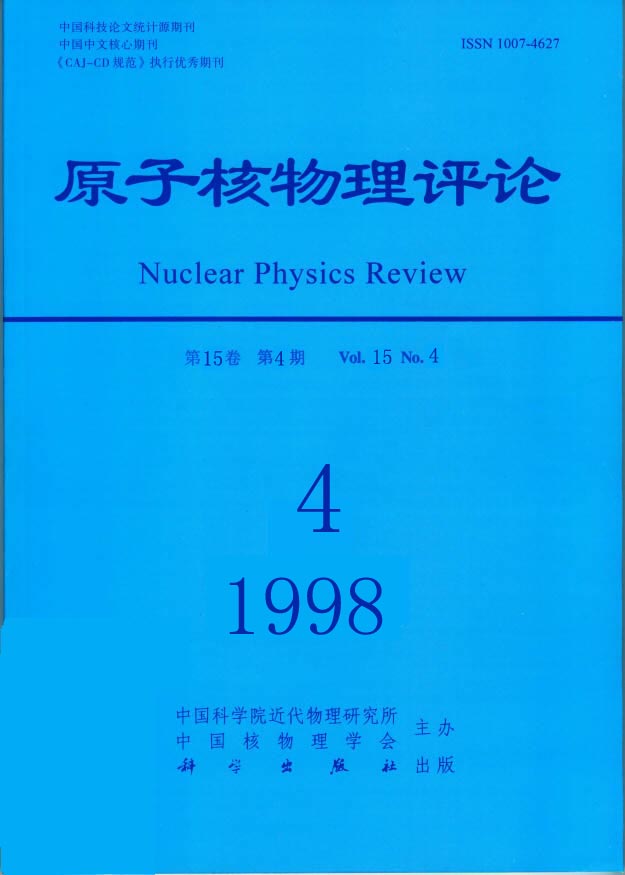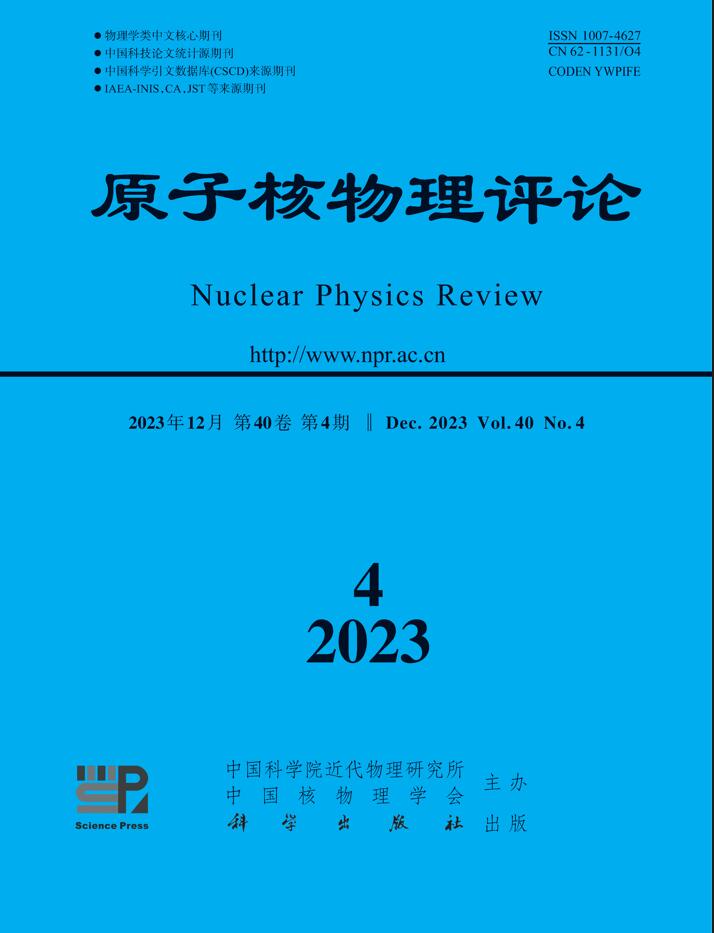1998 Vol. 15, No. 4

Display Method:
1998, 15(4): 193-197.
doi: 10.11804/NuclPhysRev.15.04.193
Abstract:
A brief introduction of the theoretical studies of liquid gas phase transition in nuclear matter and a two phase equilibrium model for studying stability of hot nuclei is presented. The critical temperature of the phase transition and its dependence on size and asymmetry of nuclear matter and Coulomb interaction are discussed. The limiting temperatures of hot nuclei calculated with various nuclear forces or models and experimental results are compared.
A brief introduction of the theoretical studies of liquid gas phase transition in nuclear matter and a two phase equilibrium model for studying stability of hot nuclei is presented. The critical temperature of the phase transition and its dependence on size and asymmetry of nuclear matter and Coulomb interaction are discussed. The limiting temperatures of hot nuclei calculated with various nuclear forces or models and experimental results are compared.
1998, 15(4): 198-202.
doi: 10.11804/NuclPhysRev.15.04.198
Abstract:
The Stability of a large deformed configuration of nuclei has been discussed from the point of view of interplay between order and chaos. A further understanding of fission dynamic and some problems on nuclear structure have been obtained.
The Stability of a large deformed configuration of nuclei has been discussed from the point of view of interplay between order and chaos. A further understanding of fission dynamic and some problems on nuclear structure have been obtained.
1998, 15(4): 203-206.
doi: 10.11804/NuclPhysRev.15.04.203
Abstract:
A new dynamical approach for measuring the temperature of a Hamiltonian dynamical system in the microcanonical ensemble of thermodynamics is presented. It shows that under the hypothesis of ergodicity the temperature can be computed as a time average of the function, ·(H/‖H‖ 2) , on the energy surface. This method not only yields an efficient computational approach for determining the temperature, but also provides an intrinsic link between dynamical system theory and the statistical...
A new dynamical approach for measuring the temperature of a Hamiltonian dynamical system in the microcanonical ensemble of thermodynamics is presented. It shows that under the hypothesis of ergodicity the temperature can be computed as a time average of the function, ·(H/‖H‖ 2) , on the energy surface. This method not only yields an efficient computational approach for determining the temperature, but also provides an intrinsic link between dynamical system theory and the statistical...
1998, 15(4): 207-219.
doi: 10.11804/NuclPhysRev.15.04.207
Abstract:
The basic theoretical methods for investigating the hot nuclei and their multifragmentation are reviewed. After the history of the studies of the liquid gas phase transition is introduced briefly, the comments on its new advances are given. The main frontiers in the corresponding fields are pointed out as well.
The basic theoretical methods for investigating the hot nuclei and their multifragmentation are reviewed. After the history of the studies of the liquid gas phase transition is introduced briefly, the comments on its new advances are given. The main frontiers in the corresponding fields are pointed out as well.
1998, 15(4): 220-226.
doi: 10.11804/NuclPhysRev.15.04.220
Abstract:
The knowledge of nuclear equation of state for which nucleonic effects are dominant is presented. The direct studies which close to the saturation state and the indirect studies involving heavy ion collisions on nuclear equation of state are reviewed.
The knowledge of nuclear equation of state for which nucleonic effects are dominant is presented. The direct studies which close to the saturation state and the indirect studies involving heavy ion collisions on nuclear equation of state are reviewed.
1998, 15(4): 227-236.
doi: 10.11804/NuclPhysRev.15.04.227
Abstract:
The methods measuring excitation energies and temperature of highly excited nuclear matter and their reliability have been summarized. According to the research and simulation the measured caloric curve has been discussed and some suggestions for further investigation of nuclear temperature were pointed out.
The methods measuring excitation energies and temperature of highly excited nuclear matter and their reliability have been summarized. According to the research and simulation the measured caloric curve has been discussed and some suggestions for further investigation of nuclear temperature were pointed out.
1998, 15(4): 237-241.
doi: 10.11804/NuclPhysRev.15.04.237
Abstract:
The equilibration in relativistic heavy ion collisions for systems 16 O+ 16 O, 40 Ca+ 40 La and 139 La+ 139 La is studied with RBUU theory. We have found that the mean field still plays a role in addition to the collision term in the equilibration process in relativistic heavy ion collisions at energy around 1 GeV/u. For finite systems, the systems do not reach complete equilibrium. But at the center zone, the local equilibrium is almost reached.
The equilibration in relativistic heavy ion collisions for systems 16 O+ 16 O, 40 Ca+ 40 La and 139 La+ 139 La is studied with RBUU theory. We have found that the mean field still plays a role in addition to the collision term in the equilibration process in relativistic heavy ion collisions at energy around 1 GeV/u. For finite systems, the systems do not reach complete equilibrium. But at the center zone, the local equilibrium is almost reached.
1998, 15(4): 242-248.
doi: 10.11804/NuclPhysRev.15.04.242
Abstract:
So far the statistical fluctuation property of the energy spectrum and its rigidity for quantum chaotic systems are known much more than the wave functions. The study of the propagating property of a quantum state of a Hamiltonian system with its initial state being a coherent state, the time evolution of the mean position and mean momentum, as well as the variation of the position and momentum fluctuation of the system will offer information about the wave function and the phase...
So far the statistical fluctuation property of the energy spectrum and its rigidity for quantum chaotic systems are known much more than the wave functions. The study of the propagating property of a quantum state of a Hamiltonian system with its initial state being a coherent state, the time evolution of the mean position and mean momentum, as well as the variation of the position and momentum fluctuation of the system will offer information about the wave function and the phase...
1998, 15(4): 249-257.
doi: 10.11804/NuclPhysRev.15.04.249
Abstract:
The Two body Correlation Transport Theory (TBCTT), its several hierarchy truncations and conservation laws for intermediate energy heavy ion collision have been investigated. This approach contains time dependent mean field, two body correlation effects and Pauli principle, the self consistent coupling between time dependent mean field and two body correlation dynamics is emphasized and preserved in realistic numerical calculation by a set of coupled dynamical equations...
The Two body Correlation Transport Theory (TBCTT), its several hierarchy truncations and conservation laws for intermediate energy heavy ion collision have been investigated. This approach contains time dependent mean field, two body correlation effects and Pauli principle, the self consistent coupling between time dependent mean field and two body correlation dynamics is emphasized and preserved in realistic numerical calculation by a set of coupled dynamical equations...
1998, 15(4): 258-261.
doi: 10.11804/NuclPhysRev.15.04.158
Abstract:
Thermalization in intermediate high energy reaction is studied by microscopic kinetic model. The calculations are carried out for reactions 830 MeV p+ 56 Fe and 40Ca ( E =35 MeV/u )+ 40Ca. The calculations show that the quasi equilibrium can be reached. It is found that there is an obvious transverse flow in the nucleus nucleus reaction process.
Thermalization in intermediate high energy reaction is studied by microscopic kinetic model. The calculations are carried out for reactions 830 MeV p+ 56 Fe and 40Ca ( E =35 MeV/u )+ 40Ca. The calculations show that the quasi equilibrium can be reached. It is found that there is an obvious transverse flow in the nucleus nucleus reaction process.
1998, 15(4): 262-265.
doi: 10.11804/NuclPhysRev.15.04.262
Abstract:
The properties of halo nuclei, especially proton halo nuclei and their experimental researches have been reviewed. The transfer reactions induced by radioactive beams and near barrier fusion with halo nucleus are discussed.
The properties of halo nuclei, especially proton halo nuclei and their experimental researches have been reviewed. The transfer reactions induced by radioactive beams and near barrier fusion with halo nucleus are discussed.
1998, 15(4): 266-273.
doi: 10.11804/NuclPhysRev.15.04.266
Abstract:
The history and current status of the experimental study of giant dipole resonance in hot rotating nuclei has been reviewed.Some open problems and new development are stressed.
The history and current status of the experimental study of giant dipole resonance in hot rotating nuclei has been reviewed.Some open problems and new development are stressed.







 甘公网安备 62010202000723号
甘公网安备 62010202000723号